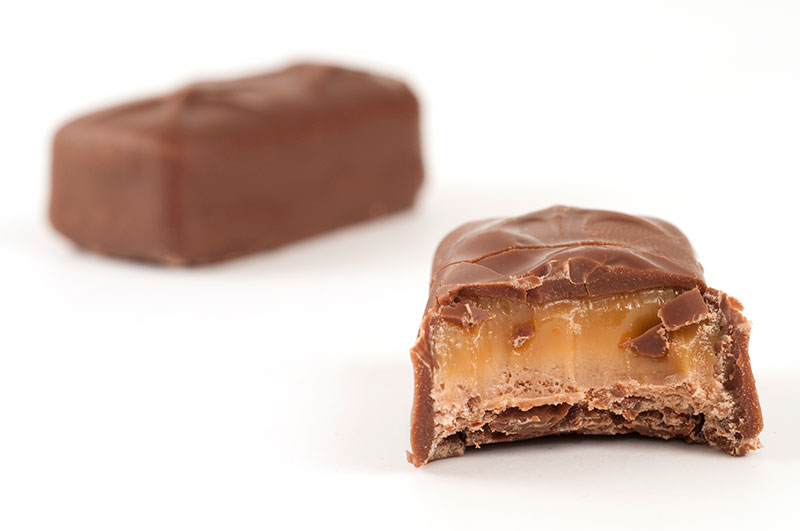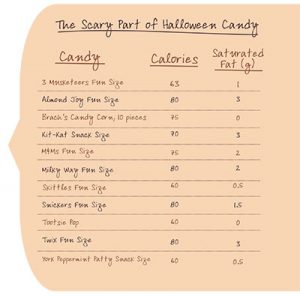Written by Jill Weisenberger —
Know what you’re getting. As a lover of sweets and all things dark chocolate, I’m the last person to advise against eating candy. However, it’s important to know what you’re getting so you can make a smart choice. Halloween treats are packed with added sugars, which do little more than give us extra calories. Perhaps even worse are the saturated and trans fat content of holiday candies. Thin or not, we should all be concerned about these unhealthy fats. Saturated and trans fats, sometimes referred to as solid fats, are linked to an increased risk of both cardiovascular disease and type 2 diabetes. Studies also link these solid fats to dementia. Check out the chart on p.35 to see what’s in your favorite candy. If yours isn’t listed, find it on the label, or on the manufacturer’s website. Compare the calories and saturated fats to your daily target to see how your candy fits in.
Most of us should limit saturated fats to about 15-20 grams daily. Ideally, we wouldn’t consume any trans fat at all, but there are traces in lots of packaged foods, so it’s hard to avoid completely. Calorie needs vary significantly. To get an estimate of your own, visit the website for the USDA
SuperTracker (supertracker.usda.gov). I’m fond of telling my patients that it’s okay to eat whatever you want, but not everything you want. In Halloween translation: Go ahead and enjoy a couple pieces of your favorite candy—even for two or three days. Then be done with it.
Make it a teachable moment. Before Halloween, talk to your kids about the candy frenzy. Ask them what they enjoy about the holiday and how much candy they think is okay to eat. Explain that healthy eating helps them grow, focus
at school and perform better on the soccer field, at ballet or during any physical activity. Look at the differences between the regular sized candies, fun size and minis. I don’t recommend talking about calories and fats to little kids, but they can and should understand the difference between junk food and food that nourishes them. Instead of banishing candy from your house or putting severe limits on it, decide together how much candy they can have and under what conditions.
Is it a couple pieces in their lunch boxes or after dinner or during a snack with a glass of milk? Experience with patients and in my own home tells me that strategy works much better because it teaches kids to moderate their own intake instead of focusing
on what they can’t have.
Eat first. So candy doesn’t become dinner, eat something beforegrabbing your trick-or-treat bags and heading down the street. Even if it seems like it’s too early for dinner, make time for a sandwich or a small bowl of stew. This is part of that teachable moment: if you eat a balanced diet, a little bit of junk can’t hurt.
Have fun without food. Play spooky music and decorate your house in orange and black. Wear a scary costume, carve a pumpkin and roast its seeds, play silly games-—like toss the beanbag into a cauldron—or create a Halloween-inspired scavenger hunt.
Forget willpower. It doesn’t work for very long for anyone! But planning ahead and choosing smart strategies do work.
Here are some ideas.
- Instead of tempting yourself with your favorite candies, buy something that you don’t like as much. If you are going to buy hard-to-resist treats to pass out on Halloween night, don’t buy them until Halloween day.
- You don’t even have to pass out candy. Consider giving trick-or-treaters popcorn, glow sticks or trinkets.
- Make temptation easier on your kids, too. Offer a candy buy-out. Let them trade their candy for movie tickets, or a new toy or for a small amount of money.
- Say no to the office dump. This is the spot in the office kitchen where all of your co-workers bring leftover candy, birthday cakes and more with the hope that others will be tempted before they are. Instead, why not gather up everyone’s loot and send it to the troops overseas (visit operationshoebox.com).


